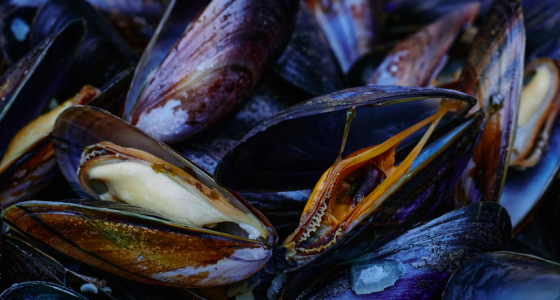Eating these freshwater invaders could come at a cost—here’s why officials are urging caution
- Replies 0
They’re showing up in unexpected places, often clinging to boats, docks, or shorelines.
They’re small, striped, and spreading fast—but what many people don’t realize is just how dangerous they might be if consumed.
While some have floated the idea of turning this invasive problem into a solution on a plate, officials and experts are urging the public to think twice.
As one recent discovery made headlines, the conversation shifted sharply from nuisance to serious concern.
More than 500,000 of these tiny mussels were discovered clinging to a single boat lift.
They were found during a coordinated effort by local aquatic invasive species specialists and wildlife officials.
The mussels had hitched a ride from a nearby recreation area.
To eliminate the threat, teams used hot water to scald the mussels, ensuring not even a trace of DNA survived.
They’re called zebra mussels, and they’ve been steadily spreading since arriving in the US decades ago.

What makes them so damaging isn’t just their rapid reproduction. They’re also aggressive filter feeders, stripping plankton from the water at unsustainable rates.
That leads to clearer waters, but not in a good way—it starves native species and exposes prey, disrupting the balance of the ecosystem.
They also wreak havoc on infrastructure by clogging water intake pipes and damaging equipment.
So when people ask whether eating these mussels could be a way to fight back, the answer is far more complicated than it seems.
Also read: Planning a beach trip this Memorial Day? Here’s one hidden danger you shouldn’t overlook
One local chef explained it clearly.
“Zebra mussels can be cooked and consumed, but I don’t think it’ll be worth the potential digestive issues that may follow,” said Petrina Peart.
Zebra mussels, unlike their saltwater counterparts, are not grown in controlled environments. They filter everything in the water—plankton, yes, but also harmful toxins and bacteria. Even thorough cooking with wine and herbs can’t guarantee all toxins or bacteria are neutralized.
Peart emphasized the risks: “There could still be potentially harmful bacteria.” Some may compare the idea to other successful efforts—like turning invasive species into cuisine.
One example given was the green iguana, which has been used in regional recipes. But there’s a critical difference: size. Zebra mussels rarely exceed two inches, making them labor-intensive and less practical for culinary use.
She noted she personally passed on iguana soup in the past, and has no plans to add zebra mussels to any future menu. “I’ll probably skip the zebra mussels too,” she said.
Experts agree that encouraging the harvesting of these mussels could backfire.
Also read: A batch of imported oysters has been recalled in the US due to health concerns
Any handling of them—especially transporting them—could lead to new infestations. Even a single larva or remnant could spark problems in previously unaffected areas. That’s why agencies continue to focus on prevention. Eradication, once zebra mussels are established, is virtually impossible.
In the Wyoming case, specialists didn’t just kill the mussels—they took measures to eliminate all DNA traces to avoid spreading.
If you spend time on the water, you can play a role in protecting local ecosystems. If mussels are still on your dinner wish list, experts suggest sticking to saltwater varieties. Farm-raised blue mussels are cultivated under controlled conditions and are far safer to eat.
Always cook thoroughly, discard any that don’t open, and pair with your favorite seasonings. And as Peart joked—“Lots of butter, lemon and fresh herbs couldn’t hurt.”
Just not on zebra mussels.
Read next: Are dangerous particles lurking in your favorite snack? Find out which brands to avoid now

Would you ever consider eating an invasive species to help the environment? Or do the risks outweigh the potential benefits? Tell us what you think in the comments—and let us know if zebra mussels belong on a plate or just off the map.
They’re small, striped, and spreading fast—but what many people don’t realize is just how dangerous they might be if consumed.
While some have floated the idea of turning this invasive problem into a solution on a plate, officials and experts are urging the public to think twice.
As one recent discovery made headlines, the conversation shifted sharply from nuisance to serious concern.
More than 500,000 of these tiny mussels were discovered clinging to a single boat lift.
They were found during a coordinated effort by local aquatic invasive species specialists and wildlife officials.
The mussels had hitched a ride from a nearby recreation area.
To eliminate the threat, teams used hot water to scald the mussels, ensuring not even a trace of DNA survived.
They’re called zebra mussels, and they’ve been steadily spreading since arriving in the US decades ago.

They’re small, striped, and spreading fast—but what many people don’t realize is just how dangerous they might be if consumed. Image Source: Gil Ndjouwou / Unsplash
What makes them so damaging isn’t just their rapid reproduction. They’re also aggressive filter feeders, stripping plankton from the water at unsustainable rates.
That leads to clearer waters, but not in a good way—it starves native species and exposes prey, disrupting the balance of the ecosystem.
They also wreak havoc on infrastructure by clogging water intake pipes and damaging equipment.
So when people ask whether eating these mussels could be a way to fight back, the answer is far more complicated than it seems.
Also read: Planning a beach trip this Memorial Day? Here’s one hidden danger you shouldn’t overlook
One local chef explained it clearly.
“Zebra mussels can be cooked and consumed, but I don’t think it’ll be worth the potential digestive issues that may follow,” said Petrina Peart.
Zebra mussels, unlike their saltwater counterparts, are not grown in controlled environments. They filter everything in the water—plankton, yes, but also harmful toxins and bacteria. Even thorough cooking with wine and herbs can’t guarantee all toxins or bacteria are neutralized.
Peart emphasized the risks: “There could still be potentially harmful bacteria.” Some may compare the idea to other successful efforts—like turning invasive species into cuisine.
One example given was the green iguana, which has been used in regional recipes. But there’s a critical difference: size. Zebra mussels rarely exceed two inches, making them labor-intensive and less practical for culinary use.
She noted she personally passed on iguana soup in the past, and has no plans to add zebra mussels to any future menu. “I’ll probably skip the zebra mussels too,” she said.
Experts agree that encouraging the harvesting of these mussels could backfire.
Also read: A batch of imported oysters has been recalled in the US due to health concerns
Any handling of them—especially transporting them—could lead to new infestations. Even a single larva or remnant could spark problems in previously unaffected areas. That’s why agencies continue to focus on prevention. Eradication, once zebra mussels are established, is virtually impossible.
In the Wyoming case, specialists didn’t just kill the mussels—they took measures to eliminate all DNA traces to avoid spreading.
If you spend time on the water, you can play a role in protecting local ecosystems. If mussels are still on your dinner wish list, experts suggest sticking to saltwater varieties. Farm-raised blue mussels are cultivated under controlled conditions and are far safer to eat.
Always cook thoroughly, discard any that don’t open, and pair with your favorite seasonings. And as Peart joked—“Lots of butter, lemon and fresh herbs couldn’t hurt.”
Just not on zebra mussels.
Read next: Are dangerous particles lurking in your favorite snack? Find out which brands to avoid now
Key Takeaways
- Experts warn the public not to eat zebra mussels due to the risk of harmful toxins and bacteria.
- Zebra mussels reproduce quickly and damage both ecosystems and infrastructure.
- Even when cooked, these freshwater mussels may carry dangerous pathogens.
- Prevention and decontamination are critical to avoid further spread.






